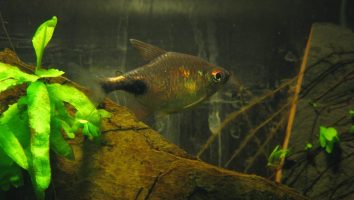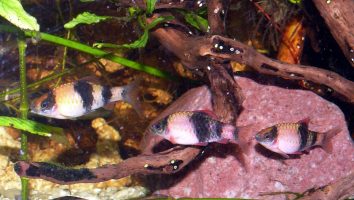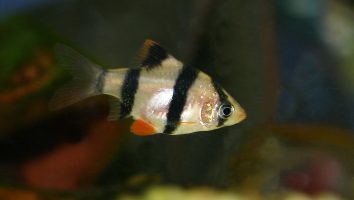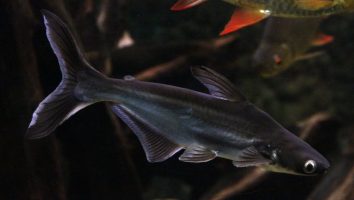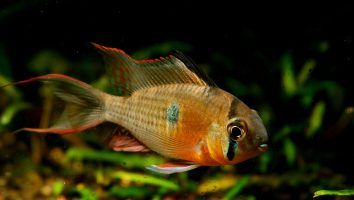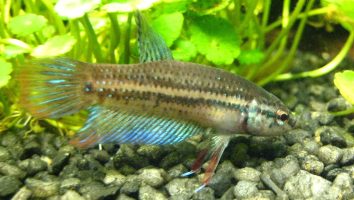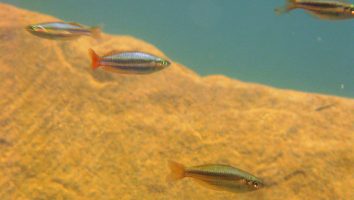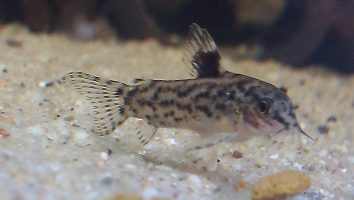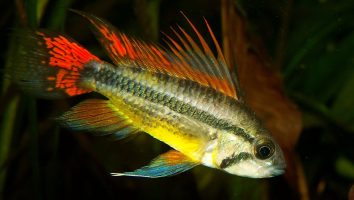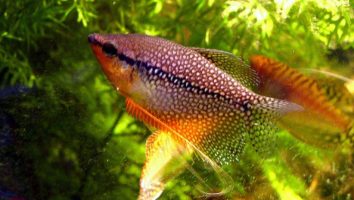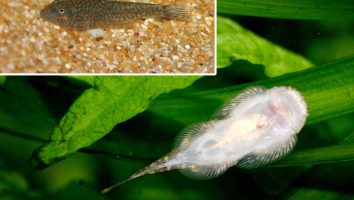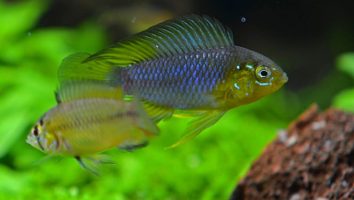The Julie cichlid (Julidochromis marlieri) is a beautiful fish that is perfect for the intermediate aquarist. They are not too difficult to care for, but they are also not the easiest fish in the world.
This species is native to Lake Tanganyika in Africa, and they are prized for their stunning coloration. They are also known to be rather peaceful, which is always a bonus.
In this guide, we will teach you everything you need to know about Julie cichlid care. You will learn about their diet, tank requirements, and more!
Table of contents
Species overview
Julie cichlids (Julidochromis regani) are a type of fish that is native to Lake Tanganyika in Africa. They are found throughout the entire lake but are most heavily concentrated near the shoreline in areas with a lot of rocks and vegetation.
This is a substrate that they are very accustomed to in the wild and something that you will want to replicate in their tank.
Julie cichlids are a peaceful species of fish that gets along well with other tank mates. They are not known to be aggressive and will usually only become territorial if they are spawning.
This is a very popular fish in the aquarium scene due to its bright colors and easy-going personality.
Appearance

The Julie cichlid is one of the most colorful freshwater fish out there. They have a very distinct color pattern that really sets them apart from other fish.
The base color of their body is a deep blue. This blue color is broken up by a series of orange, yellow, and white stripes that run horizontally along their body.
These stripes are very distinct and really stand out against the blue color. The Julie cichlid also has a very prominent black stripe that runs from their eye all the way to the base of their tail.
This black stripe is bordered on either side by a thin white stripe. The fins of the Julie cichlid are also very colorful.
The dorsal fin is tall and thin with a white leading edge and a yellow trailing edge. The rest of the fin is a deep blue color.
The anal fin is also tall and thin with a white leading edge and a yellow trailing edge. The caudal fin is forked and has a deep blue color with a yellow leading edge.
The Julie cichlid also has a very prominent black stripe that runs from their eye all the way to the base of their tail.
Lifespan
Julie cichlids have a lifespan of around 5-8 years, though some have been known to live up to 10 years. Their lifespan can be greatly impacted by the level of care they receive.
Good water quality, a nutritious diet, and tank mates that won’t harass them are all important factors in ensuring a long life for your Julie cichlid.
Size
The Julie cichlid grows to a maximum length of about 4 inches.
Tank
Tank Size
The recommended tank size for a single Julie cichlid is 75 gallons. If you want to keep more than one fish, you’ll need to add at least another 55 gallons for each additional fish.
Julie cichlids are not considered community fish, so it’s best to keep them in a tank by themselves or with other cichlids that have a similar temperament.
Water Parameters
The Julie cichlid is a freshwater fish that is native to the Amazon River basin. In the wild, they inhabit slow-moving waters with a neutral to slightly acidic pH.
To keep your Julie cichlid healthy, it’s important to maintain similar water conditions in the aquarium.
Here are some recommended water parameters for Julie cichlids:
- Water Temperature: 75-82 degrees Fahrenheit
- pH Levels: 6.5-7.5
- Water Hardness: 5-19 dGH
- Alkalinity Levels: 3-10 dKH
What To Put In Their Tank
When it comes to setting up an aquarium for Julie cichlids there are a few things you’ll want to take into consideration.
First and foremost, these fish are cichlids. This means they’re going to be fairly aggressive and territorial.
You’ll want to give them plenty of room to swim and establish their own territory. A good rule of thumb is to have at least 50 gallons for every Julie cichlid in your tank.
The next thing you’ll want to consider is the substrate. Julie cichlids love to dig and sift through the substrate looking for food.
You’ll want to use a substrate that’s soft and won’t damage their delicate fins. We recommend using something like sand or small gravel.
Another important thing to consider is the plants in your tank. Julie cichlids are known to nibble on plants, so you’ll want to choose something that can withstand a little bit of abuse.
Some good choices are hornwort, water wisteria, or java moss.
Last but not least, you’ll want to include some hiding places in your tank. These fish like to have a place to retreat to when they feel threatened.
Caves, driftwood, and rocks all make great hiding places. Just make sure that whatever you use is big enough that your fish can’t get stuck!
Common Diseases
Julie cichlids are a pretty hardy species, but that doesn’t mean they don’t get sick from time to time. The most common illness that affects them is ich, which is a parasite that manifests itself as white spots on the fish’s body.
Other potential diseases include velvet, Hole-in-the-Head, and fin rot. While these aren’t as common as ich, they can still affect your fish if the conditions are right (or wrong, in this case).
As with any other fish, the best way to keep your Julie cichlid healthy is to maintain a clean and stable tank. This will go a long way in preventing disease and keeping your fish happy and healthy.
Behavior & Temperament
The Julie cichlid is a feisty fish that is known to be one of the most aggressive cichlids. They are not afraid to fight with other fish and will often establish dominance in their tank.
Julie cichlids are also known to be very territorial. They will claim a certain area in the tank as their own and will defend it against any intruders. This behavior is most common during spawning season.
Julie cichlids are not the best fish to keep with other cichlids. They are known to be bullies and will often harass and chase other fish. If you do decide to keep them with other fish, make sure to choose fish that are much larger than the Julie cichlid.
Tank Mates
The Julie cichlid is a beautiful and peaceful fish that can make a great addition to any community tank.
These fish are relatively small, so they can be kept with a wide variety of tank mates.
Since they’re not aggressive, you don’t have to worry about them picking on smaller fish. In fact, they tend to do well with fish that are a little bit on the shy side.
Some good examples of compatible tank mates include:
- Neon Tetra
- Cardinal Tetra
- Rummy Nose Tetra
- Ghost Shrimp
- Cherry Shrimp
- Platy Fish
- Guppy
- Mollies
- Swordtails
Breeding
The Julie cichlid is a man-made species, so it’s not surprising that they’re easy to breed in captivity. If you provide them with the right habitat and water conditions, they’ll do the rest.
To start, you’ll need a breeding tank. It should be at least 30 gallons and can be set up like their regular habitat. The water should be around 80 degrees Fahrenheit with a neutral pH.
Then, you’ll need to add plenty of hiding places. Caves, rocks, and driftwood all make good options. Be sure to add enough for each fish to have their own space.
When ready, add two females for every male. As with most cichlids, the males are larger and have more color.
Feed the fish plenty of high-quality foods. Then, begin changing about 50 percent of the water. That should trigger spawning.
You’ll know you’re successful when you see the female lay her eggs on a flat surface. After she does that, the male will guard them diligently.
The eggs will hatch in about three days. You can move the babies into a nursery tank to improve their odds of survival. Feed them mashed peas and other green vegetables until they’re ready to join the adults in your main tank.
Conclusion
As you can see, there are many benefits to owning a Julie cichlid. They are a beautiful fish that will add color and life to your tank. They are also relatively easy to care for, which is a big plus.
The only downside is that they can be aggressive, so you need to be aware of that before you purchase one. Other than that, we think they make a great addition to any tank!

